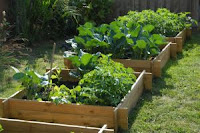The Creation of my backyard habitat for wildlife and our enjoyment and how it has grown and changed since 2004.
Wednesday, October 12, 2011
9 tips for Sensational Harvest
All across the country people are rediscovering the joys of growing their own vegetables, fruits and herbs. As well as producing fresh, flavorful food, a kitchen garden can be a source of nearly year-round enjoyment. If you are planning a fall garden or spring garden consider these ideas to improve your yield.
1. Contain your plants-Rusted washtubs; wheelbarrows, and watering cans make whimsical planters for salad greens such as ‘Red Fire’, Oakleaf, and butter lettuces. Containers add another level of interest while boosting growing space. (Be sure to drill holes for drainage.)
2. Plan for bounty & beauty-The French potager is a kitchen garden designed for visual appeal and productivity. Beginners should start small. Four 4 X 4 beds can provide one or two people with fresh greens, tomatoes, and herbs throughout the growing season. Check with your county extension service for varieties that are the best for your locality.
3. Raised beds to lift yields-Garden beds raised several inches above pathways are easier to tend, warm up faster in spring allowing for earlier planting and drain better than flat beds. Make beds 4 feet wide for easy maintenance; pathways should be 4-5 feet wide to allow easy passage with a garden cart.
4. Choose companions-Be skeptical about following of-repeated plant adages such as “plant carrots with tomatoes”. Many of these claims have not panned out in scientific trials, overcrowding beds can reduce yields. Instead, consider edging beds with compact herbs, like parsley or edible flowers like nasturtiums. Herbs and flowers add visual appeal and attract pollinators.
5. Embrace diversity-Grow herbs alongside your vegetables. Loaded with flavor and fragrance, herbs such as garlic and chives can be potent pest repellents. At the same time, tiny herb flowers attract and sustain beneficial insects and pollinators, which are critical for crop production. To reduce plant diseases, nutrient depletion, and insect pests, avoid planting the same crop in the same location is successive years.
6. Build a structure-The best kitchens gardens include a seating area--a shady place to rest and escape the heat of the day. While a well-placed shade tree will do the trick, a pergola also offers the opportunity to grow vines such as grapes.
7. Reach for the sky-Take advantage of vertical space by including climber, which produce more per square foot of garden space than bush varieties. Red-blossom ‘Painted Lady” and ‘Scarlet Runner” pole beans planted along one edge of a row of beds climb 8-foot tall stakes that form tepees over pathways. Tomatoes, peas, and vining fruits also should be supported with stakes, cages, or trellises for big blemish-free produce.
8. Blanket your soil-After the soil warm, lavish plants with a thick layer of organic mulch such as shredded leaves or grass clippings. Mulch helps retain soil moisture, blocks weeds and will gradually break down into humus-all will be beneficial to the plants growth. Mulching can also reduce plants susceptible to soil-borne diseases.
9. Plan to succeed-Double your harvest with relay crops.” Follow spring-planted veggies, such as lettuce, carrots, scallions, or peas, with late-maturing crops, such as sweet corn, melons, broccoli, or kale. Successive crops might occupy the same bed for a short time. By the time the second crop is big enough to take over the space, the first will be ready to pull out. Choose fast-maturing varieties when using this technique.
If you’ve dreamed of gathering basketfuls of sun–ripened fruits and vegetables right outside your door find a sunny location and give these tips a try.
Subscribe to:
Post Comments (Atom)



No comments:
Post a Comment